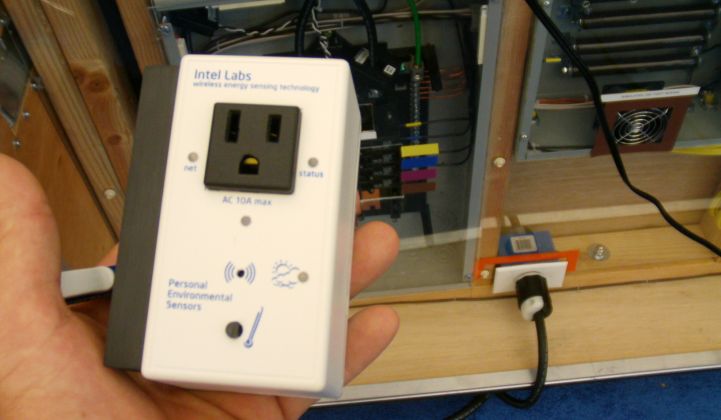How does a hardware company make money off of software?
Traditionally, Intel has solved this dilemma by simply giving away the software as a way to make its chips and motherboards more appealing than the goods from AMD or IBM.
That model, however, has begun to change at the company. Last year, Intel bought McAfee, a move that formally put Intel into the software-for-money business. These changes in turn pave the way for the commercialization of the Personal Office Energy Manager (POEM), a software layer for monitoring and perhaps one day controlling the electricity consumed by computers, servers, printers and other devices plugged into a socket. Approximately 30 percent to 60 percent of the power in a commercial building gets consumed by plug loads, but most building management systems only track the HVAC system.
The company is currently mulling different ways to get POEM to market, said Lorie Wigle, general manager of the Eco-Tech Office initiative at the company, and one possibility includes a software licensing model.
If Intel decides to commercialize POEM, you can add it to the ever-growing list of companies trying to control power in commercial office buildings. A number of relatively young companies -- Serious Energy, BuildingIQ, Scientific Conservation -- have already released products and lined up customers. Others, such as Vigilent, have decided to concentrate on specific niches, such as air conditioners in data centers. Giants such as Schneider Electric and Siemens, meanwhile, have plunked money down to acquire companies with interesting apps in this market.
Even Microsoft is getting into the act. In March, Rob Bernard, chief environmental strategist at Microsoft, said the company was ramping down Hohm, its home management project, to concentrate on commercial office space.
Intel will likely represent a competitive threat and an attractive partner. The company is well known, of course, and can leverage all sorts of connections. On the other hand, POEM really concentrates on plug loads while a large number of others focus on HVAC. Intel Capital invested in Scientific Conservation, which monitors HVAC, and will install Scientific's software in some buildings. A combination of these two applications could, potentially, be pitched to the market as a more comprehensive solution. (The picture, by the way, shows WEST, a prototype developed by Intel that monitors energy consumption. Data from WEST gets forwarded to a PC, which then parses the data to determine which appliances are using different amounts of power.)
POEM, interestingly, also has a PC angle. The company will start to encourage notebook and desktop makers to incorporate temperature and light sensors into their products. The first versions will include the sensors on a USB stick, but eventually they will migrate inside the PC. This could make every PC a sensor bank, similar to the way Redwood Systems wants to turn every light fixture into a sensor. Turning PCs into interior weather sensors, however, wouldn't take any retrofitting. Motion sensors could be added too.
POEM came about by accident. In 2009, Bouygues Immobilier, a large property developer in France, launched plans to build an energy positive building that would produce more energy than it consumed. The idea was to leapfrog regulations by at least ten years. The company pulled in partners like Philips and Schneider, but it soon realized that it had no way to monitor and model plug loads. Bouygues called Intel Paris -- and the rest is history.
Intel will install POEM in some of its own office buildings (but not the test and measurement facilities) in Costa Rica soon.
Other energy-related matters at Intel:
--Energy is clearly a greater part of the company's overall plans. It is not just a "we do energy too" sort of thing. The company's chip group now focuses development around three principles: connectivity, security and energy-efficient performance. In corporate slide decks, "energy efficient" is in slightly smaller print than "performance" -- but it's there.
--Intel is part of various companies and groups coming up with better metrics for data centers. You've heard of PUE, or power-use effectiveness, a ratio that measures total power consumption and total power consumption used for computing. Expect to hear more in the future about WUE, or water-use effectiveness, and ERUE, or energy-reuse effectiveness, or recycling waste heat from computers for building heat.
--The company will work more closely with supercomputer developers to tweak algorithms, chips and designs for better weather modeling.
--In smart grid, expect to see companies like Moxa start to offer servers for controlling assets in the field like substations. These servers will be hardened versions of regular servers, but powered by Xeon or Atom chips.



